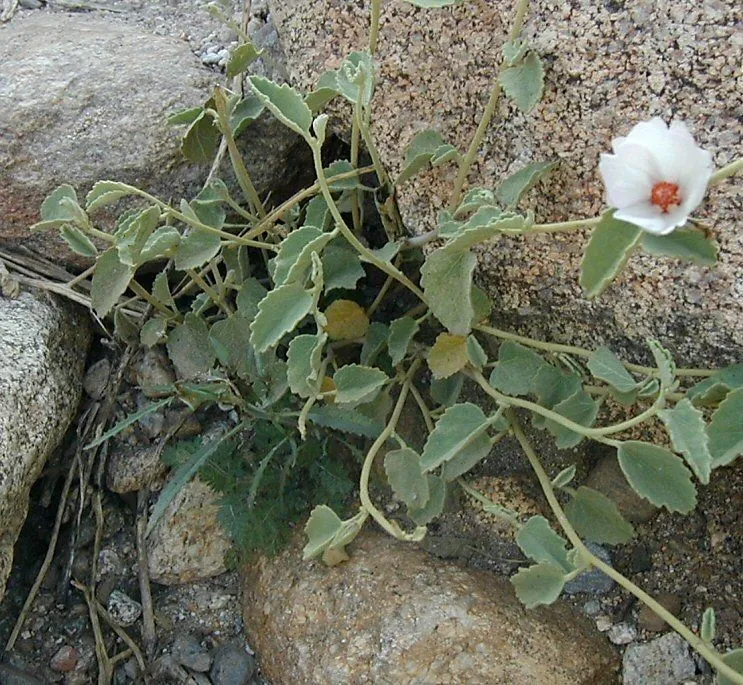
Author: Benth.
Bibliography: Bot. Voy. Sulphur: 7 (1844)
Year: 1844
Status: accepted
Rank: species
Genus: Hibiscus
Vegetable: False
Observations: SW. & SC. U.S.A. to N. & E. Mexico
Paleface, known scientifically as Hibiscus denudatus, is a perennial shrub cherished for its distinctive and delicate beauty. This species is a proud member of the Malvaceae family, a diverse group renowned for their attractive and often showy flowers.
First formally documented in 1844 in the “Botanical Voyage of the Sulphur,” as described by the botanist Benth., Hibiscus denudatus has since captured the admiration of botanists and gardening enthusiasts alike. Its name “Paleface” eloquently captures the plant’s ethereal and pale-colored blossoms, which stand out in stark, beautiful contrast against the more rugged landscapes in which it thrives.
Geographically, Hibiscus denudatus is primarily found in the southwestern and south-central regions of the United States, extending its range into the northern and eastern parts of Mexico. This hardy plant has adapted well to these often arid and challenging environments, displaying resilience that is characteristic of many species within the Malvaceae family.
The foliage of the Paleface is typically sparse, matching its specific epithet ‘denudatus,’ which means ‘stripped or bare,’ highlighting the plant’s relatively limited leaf coverage. However, this apparent sparseness only serves to emphasize the striking appearance of its flowers. The blossoms themselves are often white to light pink, featuring a five-petaled structure that’s typical of the Hibiscus genus, making them stand out vividly against the background of their natural habitat.
Hibiscus denudatus plays an essential role in the ecosystem, providing nectar and habitat for a variety of pollinators, including bees, butterflies, and hummingbirds. As a native plant, it helps maintain the ecological balance and supports biodiversity in the regions it inhabits.
For those interested in cultivating Paleface, it requires minimal maintenance, making it a perfect addition to xeriscaped gardens and native plant landscapes. Its ability to thrive in full sun and dry soil conditions make it an admirable choice for gardeners looking to add a touch of resilient beauty to their surroundings.
In summary, the Paleface, or Hibiscus denudatus, is a shining example of nature’s adaptability and grace. Its historical significance, ecological value, and aesthetic appeal make it a remarkable species within the Malvaceae family.
Eng: desert hibiscus, paleface, paleface rose-mallow, rock hibiscus
En: Paleface, Desert hibiscus, Rock hibiscus, Paleface rose-mallow
Zh: 石槿
Taken Jan 8, 2015 by EOL − Keir Morse (cc-by-nc-sa)
Taken Oct 9, 2009 by EOL − Barry Breckling (cc-by-nc-sa)
Taken Jan 8, 2015 by EOL − Keir Morse (cc-by-nc-sa)
Taken May 26, 2012 by EOL − Keir Morse (cc-by-nc-sa)
Taken Mar 11, 2016 by EOL − Christian Schwarz (cc-by-nc)
Taken May 26, 2012 by EOL − Keir Morse (cc-by-nc-sa)
Taken Jan 8, 2015 by EOL − Keir Morse (cc-by-nc-sa)
Taken May 26, 2012 by EOL − Keir Morse (cc-by-nc-sa)
Taken Oct 9, 2009 by EOL − Barry Breckling (cc-by-nc-sa)
Taken Jan 8, 2015 by EOL − Keir Morse (cc-by-nc-sa)
Taken Jan 8, 2015 by EOL − Keir Morse (cc-by-nc-sa)
Taken May 26, 2012 by EOL − Keir Morse (cc-by-nc-sa)
Taken May 26, 2012 by EOL − Keir Morse (cc-by-nc-sa)
Taken Feb 15, 2016 by EOL − matthew_salkiewicz (cc-by-nc)
Taken May 26, 2012 by EOL − Keir Morse (cc-by-nc-sa)
Taken Jan 8, 2015 by EOL − Keir Morse (cc-by-nc-sa)
Taken May 26, 2012 by EOL − Keir Morse (cc-by-nc-sa)
Taken May 26, 2012 by EOL − Keir Morse (cc-by-nc-sa)
© copyright of the Board of Trustees of the Royal Botanic Gardens, Kew.
© copyright of the Board of Trustees of the Royal Botanic Gardens, Kew.
Growth habit>: Subshrub
Family: Myrtaceae Author: (F.Muell.) K.D.Hill & L.A.S.Johnson Bibliography: Telopea 6: 402 (1995) Year: 1995 Status:…
Family: Rubiaceae Author: Pierre ex A.Froehner Bibliography: Notizbl. Bot. Gart. Berlin-Dahlem 1: 237 (1897) Year:…
Family: Sapindaceae Author: Koidz. Bibliography: J. Coll. Sci. Imp. Univ. Tokyo 32(1): 38 (1911) Year:…
Family: Asteraceae Author: A.Gray Bibliography: Pacif. Railr. Rep.: 107 (1857) Year: 1857 Status: accepted Rank:…
Family: Fabaceae Author: Medik. Bibliography: Vorles. Churpfälz. Phys.-Ökon. Ges. 2: 398 (1787) Year: 1787 Status:…
Family: Aspleniaceae Author: (Cav.) Alston Bibliography: Bull. Misc. Inform. Kew 1932: 309 (1932) Year: 1932…